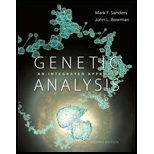
Genetic Analysis: An Integrated Approach (2nd Edition)
2nd Edition
ISBN: 9780321948908
Author: Mark F. Sanders, John L. Bowman
Publisher: PEARSON
expand_more
expand_more
format_list_bulleted
Concept explainers
Question
Chapter 11, Problem 11P
Summary Introduction
To analyze:
Question asked describe the reason why viruses are termed as “particles” and not as “cells” and why they are categorized as “obligate
Introduction:
Virus is a microscopic living particle. Organization of viral genetic material is packed by the protein coat called as capsid. Genetic material of virus is double stranded or single stranded, which is either RNA or DNA. Virus has the ability to infect all living forms, which include bacteria, archaea, and they can also infect plants as well as animals.
Expert Solution & Answer
Want to see the full answer?
Check out a sample textbook solution
Students have asked these similar questions
What is the structure and function of Eukaryotic cells, including their organelles? How are Eukaryotic cells different than Prokaryotic cells, in terms of evolution which form of the cell might have came first? How do Eukaryotic cells become malignant (cancerous)?
What are the roles of DNA and proteins inside of the cell? What are the building blocks or molecular components of the DNA and proteins? How are proteins produced within the cell? What connection is there between DNA, proteins, and the cell cycle? What is the relationship between DNA, proteins, and Cancer?
Why cells go through various types of cell division and how eukaryotic cells control cell growth through the cell cycle control system?
Chapter 11 Solutions
Genetic Analysis: An Integrated Approach (2nd Edition)
Ch. 11 - Prob. 1PCh. 11 - Prob. 2PCh. 11 - Bacterial DNA is compacted by two principal...Ch. 11 - 10.2 The human genome contains contains base...Ch. 11 - 10.1 Give descriptions for the following...Ch. 11 - 10.4 Describe the importance of light and dark G...Ch. 11 - In eukaryotic DNA, Where are you most likely to...Ch. 11 - Prob. 8PCh. 11 - Human late prophase karyotypes have about 2000...Ch. 11 - 10. What are the two or three most essential...
Ch. 11 - Prob. 11PCh. 11 - Prob. 12PCh. 11 - A researcher interested in studying a human gene...Ch. 11 - Prob. 14PCh. 11 - 10.11 In what way does position effect variegation...Ch. 11 - 16. What are chromosome territories, and what...Ch. 11 - Prob. 17PCh. 11 - Prob. 18PCh. 11 - 10.18 A survey of organisms living deep in the...Ch. 11 - A eukaryote with a diploid number of 2n=6 carries...Ch. 11 - The accompanying chromosome diagram represents a...Ch. 11 - Suppose the genome of a bacterium contains a...Ch. 11 - DNaseI cuts DNA that is not directly associated...Ch. 11 - 10.17 Histone protein isolated from pea plants...Ch. 11 - 25. The molecular probes used in FISH can detect...Ch. 11 - Experimental evidence demonstrates that the...Ch. 11 - Prob. 27PCh. 11 - Genomic DNA from the nematode worm...Ch. 11 - What function do histone proteins perform in...Ch. 11 - Based on discussions of specific proteins and...
Knowledge Booster
Learn more about
Need a deep-dive on the concept behind this application? Look no further. Learn more about this topic, biology and related others by exploring similar questions and additional content below.Similar questions
- In one paragraph show how atoms and they're structure are related to the structure of dna and proteins. Talk about what atoms are. what they're made of, why chemical bonding is important to DNA?arrow_forwardWhat are the structure and properties of atoms and chemical bonds (especially how they relate to DNA and proteins).arrow_forwardThe Sentinel Cell: Nature’s Answer to Cancer?arrow_forward
- Molecular Biology Question You are working to characterize a novel protein in mice. Analysis shows that high levels of the primary transcript that codes for this protein are found in tissue from the brain, muscle, liver, and pancreas. However, an antibody that recognizes the C-terminal portion of the protein indicates that the protein is present in brain, muscle, and liver, but not in the pancreas. What is the most likely explanation for this result?arrow_forwardMolecular Biology Explain/discuss how “slow stop” and “quick/fast stop” mutants wereused to identify different protein involved in DNA replication in E. coli.arrow_forwardMolecular Biology Question A gene that codes for a protein was removed from a eukaryotic cell and inserted into a prokaryotic cell. Although the gene was successfully transcribed and translated, it produced a different protein than it produced in the eukaryotic cell. What is the most likely explanation?arrow_forward
- Molecular Biology LIST three characteristics of origins of replicationarrow_forwardMolecular Biology Question Please help. Thank you For E coli DNA polymerase III, give the structure and function of the b-clamp sub-complex. Describe how the structure of this sub-complex is important for it’s function.arrow_forwardMolecular Biology LIST three characteristics of DNA Polymerasesarrow_forward
arrow_back_ios
SEE MORE QUESTIONS
arrow_forward_ios
Recommended textbooks for you
 Biology Today and Tomorrow without Physiology (Mi...BiologyISBN:9781305117396Author:Cecie Starr, Christine Evers, Lisa StarrPublisher:Cengage Learning
Biology Today and Tomorrow without Physiology (Mi...BiologyISBN:9781305117396Author:Cecie Starr, Christine Evers, Lisa StarrPublisher:Cengage Learning Concepts of BiologyBiologyISBN:9781938168116Author:Samantha Fowler, Rebecca Roush, James WisePublisher:OpenStax College
Concepts of BiologyBiologyISBN:9781938168116Author:Samantha Fowler, Rebecca Roush, James WisePublisher:OpenStax College Comprehensive Medical Assisting: Administrative a...NursingISBN:9781305964792Author:Wilburta Q. Lindh, Carol D. Tamparo, Barbara M. Dahl, Julie Morris, Cindy CorreaPublisher:Cengage Learning
Comprehensive Medical Assisting: Administrative a...NursingISBN:9781305964792Author:Wilburta Q. Lindh, Carol D. Tamparo, Barbara M. Dahl, Julie Morris, Cindy CorreaPublisher:Cengage Learning


Biology Today and Tomorrow without Physiology (Mi...
Biology
ISBN:9781305117396
Author:Cecie Starr, Christine Evers, Lisa Starr
Publisher:Cengage Learning

Concepts of Biology
Biology
ISBN:9781938168116
Author:Samantha Fowler, Rebecca Roush, James Wise
Publisher:OpenStax College

Comprehensive Medical Assisting: Administrative a...
Nursing
ISBN:9781305964792
Author:Wilburta Q. Lindh, Carol D. Tamparo, Barbara M. Dahl, Julie Morris, Cindy Correa
Publisher:Cengage Learning

